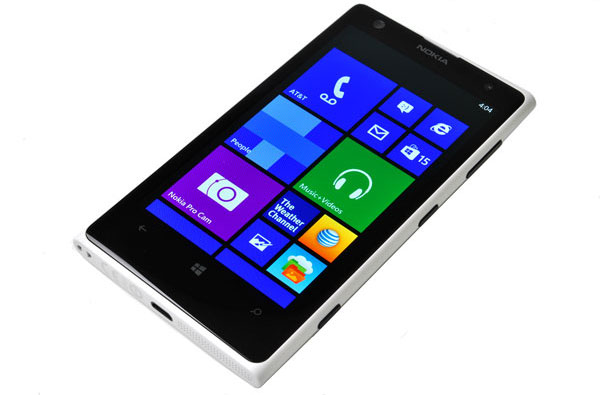Nokia Lumia 1020 Smartphone Review
Design and Build Quality
We've reviewed a multitude of Nokia Lumia devices over the years, and you don't have to have a Ph.D in design to realize that there's serious uniformity across the range. While the Lumia 1020 is bigger, bolder and more powerful than the Lumias that have come before it, it's still very much a Lumia. The smooth, curved back is still here, as are the flat, perforated ends. The PureMotion HD+ OLED display is here as well. In a lot of ways, the Lumia 1020 is an evolution of the Lumia 920. The processor speed is the same, the screen size is the same, and the battery size is the same.
But here's the difference: the rear. The Lumia 1020's standout feature is obviously the rear-facing 41MP camera, boasting optical image stabilization, a f/2.2 6-element lens, and a LED + Xenon flash combination. Those who have largely ignored smaller, featurephone platforms may not be aware of a Nokia handset branded the PureView 808, but that's actually an important phone to take inventory of when evaluating the Lumia 1020.
While the PureView 808, a Symbian-based featurephone, looked nothing like a Lumia, it did ship with a 41MP camera. That's right; in some ways, this is actually Nokia's second attempt to woo photographers with a phone. The difference, of course, is that the Lumia 1020 is a bona fide smartphone, with a legitimate smartphone operating system to better take advantage of all of those megapixels. The PureView 808 is over a year old at this stage, but it's clear that Nokia has learned a lot from that design.
The camera on the rear of the Lumia 1020 barely produces a bulge. While it's noticeable, it's hardly a deal-breaker. If you want to see a smartphone design that's notably changed by a camera, just take one peek at the Galaxy S4 Zoom. This phone is nothing of that caliber. We'll touch on the specifics of the imaging inclusions in a future page, but for now, it's worth noting that this phone will ship exclusively on AT&T in the United States, with three color options to choose from: white, yellow, and black. All of these boast a matte finish, as well as an anti-fingerprint coating that works well in practice.
For those familiar with the Lumia line, everything else is right where you'd think it would be. There's a micro-USB port on the bottom; a volume rocker, camera shutter button and power button along the right edge; a headphone jack (3.5mm) and microSIM tray along the top; and nothing at all along the left edge. It's slightly lighter than the Lumia 920, marginally thinner than the 920, and slightly wider than the 920. It's really close to being the same in terms of raw dimensions, but it feels different in the hand. It's the first Lumia to truly feel big, and it'll take some getting used to. As we've seen with phablets such as the Note, however, that's nothing that users can't overcome.
But here's the difference: the rear. The Lumia 1020's standout feature is obviously the rear-facing 41MP camera, boasting optical image stabilization, a f/2.2 6-element lens, and a LED + Xenon flash combination. Those who have largely ignored smaller, featurephone platforms may not be aware of a Nokia handset branded the PureView 808, but that's actually an important phone to take inventory of when evaluating the Lumia 1020.
While the PureView 808, a Symbian-based featurephone, looked nothing like a Lumia, it did ship with a 41MP camera. That's right; in some ways, this is actually Nokia's second attempt to woo photographers with a phone. The difference, of course, is that the Lumia 1020 is a bona fide smartphone, with a legitimate smartphone operating system to better take advantage of all of those megapixels. The PureView 808 is over a year old at this stage, but it's clear that Nokia has learned a lot from that design.
The camera on the rear of the Lumia 1020 barely produces a bulge. While it's noticeable, it's hardly a deal-breaker. If you want to see a smartphone design that's notably changed by a camera, just take one peek at the Galaxy S4 Zoom. This phone is nothing of that caliber. We'll touch on the specifics of the imaging inclusions in a future page, but for now, it's worth noting that this phone will ship exclusively on AT&T in the United States, with three color options to choose from: white, yellow, and black. All of these boast a matte finish, as well as an anti-fingerprint coating that works well in practice.
For those familiar with the Lumia line, everything else is right where you'd think it would be. There's a micro-USB port on the bottom; a volume rocker, camera shutter button and power button along the right edge; a headphone jack (3.5mm) and microSIM tray along the top; and nothing at all along the left edge. It's slightly lighter than the Lumia 920, marginally thinner than the 920, and slightly wider than the 920. It's really close to being the same in terms of raw dimensions, but it feels different in the hand. It's the first Lumia to truly feel big, and it'll take some getting used to. As we've seen with phablets such as the Note, however, that's nothing that users can't overcome.








